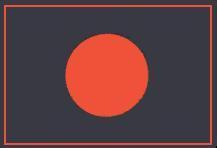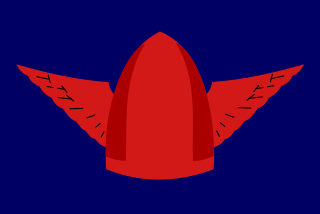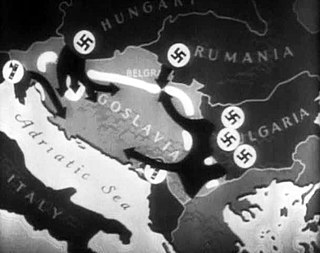
The 4th Indian Infantry Division, also known as the Red Eagle Division, is an infantry division of the Indian Army. This division of the British Indian Army was formed in Egypt in 1939 during the Second World War. During the Second World War, it took part in campaigns in East Africa, Syria, North Africa and Italy. Post independence, the division is part of the I Corps and headquartered at Prayagraj.

The 5th Indian Infantry Division was an infantry division of the Indian Army during World War II that fought in several theatres of war and was nicknamed the "Ball of Fire". It was one of the few Allied divisions to fight against three different armies - the Italian, German and Japanese armies.

The 23rd Infantry Brigade was an infantry brigade of the British Army that saw active service in the First World War, mainly on the Western Front During the Second World War, the brigade saw active service in the Syria-Lebanon Campaign, the Western Desert Campaign, and the Burma Campaign.

The 11th Security Force Assistance Brigade is a brigade of the British Army which is intended to train and assist foreign forces. In 2021, under the Future Army changes, the brigade was redesignated, formerly being the 11th Infantry Brigade & HQ South East. Prior to the Army 2020 changes in 2013, the brigade was temporarily activated for deployment to Afghanistan. Originally formed in the Second Boer War, the brigade was engaged during both World Wars.

The 29th Infantry Brigade was an infantry brigade unit of the British Army. It was originally raised in 1914 and saw service during the First and Second World Wars and the Korean War.

The 214th Infantry Brigade was an infantry brigade of the British Army raised during the Second World War that saw active service on the North West Europe.
The 101st Jäger Division was a light infantry Division of the German Army in World War II. It was formed in July 1942 by the redesignation of the 101st (Light) Infantry Division, which was itself formed in December 1940. The Walloon Legion was briefly attached to this division from December 1941 to January 1942. The Division took part in the Battle of Kharkov, the Battle of the Caucasus, and the retreat into the Kuban, where it suffered heavy losses fighting both the Red Army and partisans. The division was then involved in the battles in the Kuban bridgehead before being evacuated. The 101st was subsequently transferred to the lower Dnieper River in late 1943. It was part of the 1st Panzer Army that was surrounded in March 1944; it formed the rear guard for the XLVI Panzer Corps during the breakout of the Kamenets-Podolsky pocket. The division then retreated across Ukraine. In October 1944, it was moved to Slovakia and took part in the Battle of the Dukla Pass.

The Axis order of battle for the invasion of Yugoslavia was made up of the various operational formations of the German Wehrmacht and Waffen-SS, Italian Armed Forces and Hungarian Armed Forces that participated in the invasion of Yugoslavia during World War II, commencing on 6 April 1941. It involved the German 2nd Army, with elements of the 12th Army and a panzer group combined with overwhelming Luftwaffe support. The eighteen German divisions included five panzer divisions, two motorised infantry divisions and two mountain divisions. The German force also included two well-equipped independent motorised regiments and was supported by over 800 aircraft. The Italian 2nd Army and 9th Army committed a total of 22 divisions, and the Royal Italian Air Force had over 650 aircraft available to support the invasion. The Hungarian 3rd Army also participated, with support from the Royal Hungarian Air Force.
The 3rd Army was a Royal Yugoslav Army formation commanded by Armijski đeneral Ilija Brašić during the German-led Axis invasion of the Kingdom of Yugoslavia in April 1941 during World War II. It consisted of two reinforced infantry divisions, two infantry divisions, and a brigade-strength horsed cavalry detachment. It formed part of the 3rd Army Group, and was responsible for the Yugoslav-Albania border between Lake Ohrid and Lake Skadar.

Petar Nedeljković was an army general in the Royal Yugoslav Army who commanded the 4th Army during the German-led invasion of Yugoslavia of April 1941 during World War II. Nedeljković's command consisted of three divisions, a brigade-strength infantry detachment, one horsed cavalry regiment and one infantry regiment. The 4th Army was responsible for the Yugoslav-Hungarian border and was deployed behind the Drava between Varaždin and Slatina.
The 1st Motorised Brigade was a formation of the Royal Hungarian Army that participated in the Axis invasion of Yugoslavia during World War II.
The 2nd Motorised Brigade was a formation of the Royal Hungarian Army that participated in the Axis invasion of Yugoslavia during World War II.
The 10th Infantry Brigade was a formation of the Royal Hungarian Army that participated in the Axis invasion of Yugoslavia during World War II.
The 11th Infantry Brigade was a formation of the Royal Hungarian Army that participated in the Axis invasion of Yugoslavia during World War II.
The 12th Infantry Brigade was a formation of the Royal Hungarian Army that participated in the Axis invasion of Yugoslavia during World War II.
The 14th Infantry Brigade was a formation of the Royal Hungarian Army that participated in the Axis invasion of Yugoslavia during World War II.
The I Corps was a formation of the Royal Hungarian Army that participated in the Axis invasion of Yugoslavia during World War II.
The 13th Infantry Brigade was a formation of the Royal Hungarian Army that participated in the Axis invasion of Yugoslavia during World War II.
The 15th Infantry Brigade was a formation of the Royal Hungarian Army that participated in the Axis invasion of Yugoslavia during World War II.
The 9th Infantry Brigade was a formation of the Royal Hungarian Army that participated in the Axis invasion of Yugoslavia during World War II.







